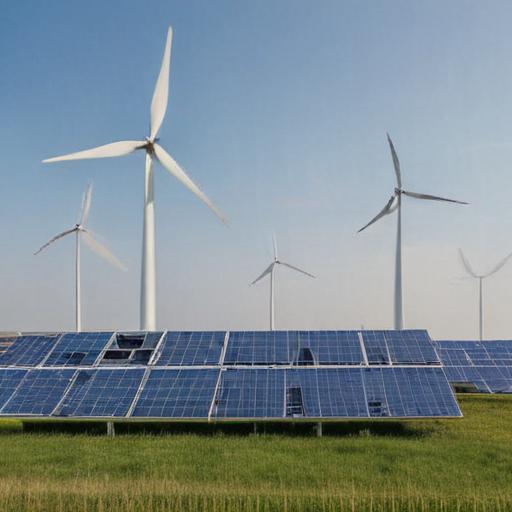The energy transition is no longer a distant goal for utilities; it is a current priority. For DTE Energy, shifting from fossil fuels to renewables is both a regulatory obligation and a strategic growth engine. Against a backdrop of inflation, rate uncertainty, and geopolitical risk, DTE’s bold capital allocation toward clean energy and grid modernization raises a key question: does its valuation and momentum support a durable long-term investment thesis?
Strategic Capital Allocation: Building a Resilient Energy Future
DTE Energy has laid out a $30 billion five-year capital plan for 2025–2029 that wires its growth with decarbonization. By 2029, the plan aims to add about 3,200 megawatts of solar, 1,000 megawatts of wind, and 430 megawatts of battery storage, all while upgrading the grid to integrate intermittent renewables. These investments align with Michigan’s aim for 100% clean energy by 2040 and are reinforced by federal incentives under the Inflation Reduction Act.
The IRA reshapes DTE’s cost structure by unlocking generous tax credits for renewables and storage, enabling the company to pass savings to customers while keeping energy affordable. The Infrastructure Recovery Mechanism (IRM) is a cornerstone of this approach, rising from $290 million in 2025 to $1 billion by 2029 to ensure cost recovery for grid upgrades. Coupled with an anticipated $3.3 billion in operating cash flow in 2025, DTE can fund its capital plan with limited equity issuance through 2027, preserving shareholder value.
Beyond compliance, DTE is pursuing non-traditional growth by securing 3–4 gigawatts of clean energy contracts with data centers. This sector is expected to add about 7 gigawatts of load by 2032, presenting a meaningful opportunity to diversify revenue and capitalize on the digital economy’s demand for clean power.
Alignment with Regulatory and Market Trends
DTE’s strategy is closely tied to regulatory and market dynamics shaping the energy sector. Michigan’s clean energy mandate provides a favorable backdrop, but the company’s success hinges on delivering reliability and affordability alongside decarbonization. Grid modernization efforts—installing 220 smart grid devices and replacing 1,560 utility poles—have contributed to tangible improvements, including a 70% reduction in outage times in 2024.
The CleanVision Integrated Resource Plan (IRP) outlines a 20-year roadmap to retire coal and replace it with renewables, with a net-zero target by 2050. Earnings growth remains central to this plan: DTE targets 2025 operating earnings per share (EPS) of $7.09–$7.23, and the company projects 10.6% annualized EPS growth over the next five years, with an implied 7.71% annualized rate through 2029. This combination of earnings discipline and transition-focused investments supports a resilient growth trajectory.
Valuation and Volatility: A Compelling Entry Point?
Long-term investors will weigh DTE’s valuation alongside its leverage. The stock trades at a P/E of about 18.9, below the sector average, suggesting potential undervaluation. However, debt remains a focal point: a debt-to-equity ratio around 203% signals elevated leverage. In a rising-rate environment, debt risk is a real consideration, though DTE’s regulated utility model and robust cash flow help cushion the impact. The company’s target of 6–8% annualized EPS growth through 2029 adds a layer of confidence for debt service and shareholder upside. On the other hand, DTE’s stock has relatively low volatility, with an average weekly move around 2.1%—a trait attractive to investors seeking steadier exposure amid market turbulence.
Risks and Rewards in the Energy Transition
No investment is without risk. DTE’s reliance on regulatory approvals for rate adjustments and capital recovery mechanisms introduces policy and timing uncertainty. Any policy shifts or project delays could pressure financial performance. The high leverage also demands disciplined capital management to avoid overextension.
Yet the upside is meaningful. DTE’s alignment with the energy transition—supported by IRA incentives, strategic data-center partnerships, and a disciplined capital plan—positions it to outperform peers over the long run. The 3.1% dividend yield and a 62% payout ratio offer an income stream while remaining focused on reinvestment and growth.
Commentary: What the plan means for long-term investors
DTE Energy’s approach exemplifies how utilities can advance decarbonization while preserving profitability and reliability. The combination of grid modernization, renewable expansion, and diversified demand—from data centers to digital infrastructure—creates a durable growth engine. The IRA’s incentives and the IRM framework reduce near-term capital risk, helping the company fund its ambitious plan without excessive equity dilution. Still, investors should monitor regulatory developments, project execution timelines, and the debt trajectory as key indicators of how the plan translates into sustainable performance.
What to watch going forward
– IRM and capital recovery timing: How quickly rate cases and approvals translate into realized cash flow and shareholder value.
– Data-center contracts: The pace and credit quality of 3–4 GW of clean-energy deals with data centers and their impact on earnings diversity.
– Grid reliability metrics: Ongoing improvements in outage times and service reliability as a signal of execution success.
– IRP milestones: Progress toward the net-zero 2050 target and the pace of coal retirement versus the addition of renewables.
– Debt management: The company’s ability to maintain a sustainable leverage profile while meeting growing capex and dividend commitments.
Summary
DTE Energy’s aggressive 2025–2029 capital plan places it squarely in the vanguard of the utility sector’s transition to a cleaner, more flexible grid. With IRA-driven economics, strong cash flow, and a diversified growth path including data-center demand, the company is positioning itself for long-term value creation. While elevated leverage warrants caution, the combination of regulatory support, steady earnings potential, and a favorable risk-reward profile makes DTE a compelling candidate for investors seeking exposure to the accelerated shift to clean energy and modernized infrastructure. The next few years will be pivotal in confirming the plan’s ability to deliver reliable, affordable clean power at scale.
